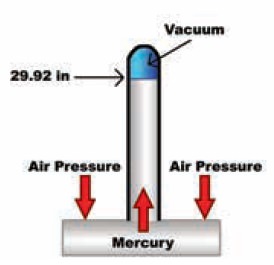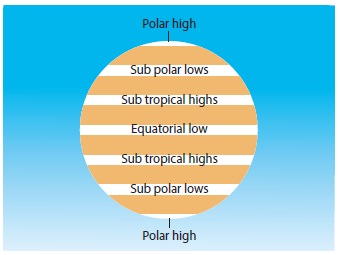Chapter: 9th Social Science : Geography : Atmosphere
Pressure - Elements of Weather and Climate
Pressure
The atmospheric pressure is the weight exerted by
air on a particular area of the earth surface. It is measured with a mercury
barometer and the unit of measurement is millibar
(mb).

The distribution of atmospheric pressure on the
surface of the earth is not uniform. It varies both vertically and
horizontally.
Vertical distribution of atmospheric pressure:
Air pressure decreases with altitude. The air
molecules become scattered and more widely spaced at higher altitudes. The air
pressure decreases by 34 millibars per 300 metres increase in height.
Horizontal distribution of atmospheric pressure:
The horizontal distribution of atmospheric pressure
in the world is not uniform. It varies from time to time and place to place due
to (i) air temperature (ii) the earth's rotation (iii) presence of water vapour
etc., The pressure belts along the
latitudes are characterized by alternate high or low pressure belts. The
pressure belts of the world are:
·
Equatorial low
·
Sub tropical highs
·
Sub polar lows
·
Polar highs

The Equatorial Low Pressure Belt:
This belt extends from equator to 5° N and 5° S
latitudes. At the equator, the earth gets heated by the vertical sun rays and
in turn heats the air in contact with it. The heated air expands and raises
upwards resulting in a low pressure belt. This belt is called doldrums due to virtual absence of
surface winds.
The Subtropical High Pressure Belts:
The sub-tropical high pressure belts extend from
the tropics to about 35° latitudes in both the hemispheres. The air that raises
in the equatorial region, becomes cold and heavy, and starts to descend in the
Sub Tropical regions. This result in sub tropical high pressure belts referred
as the Horse latitude.

The Sub-polar Low Pressure Belts:
The sub- polar low pressure belts extend between
45°N and the Arctic Circle in the northern hemisphere and between 45°S and the
Antarctic Circle in the southern hemisphere. The air present in this layer
moves to the sub tropical high pressure belt and polar high pressure belt
making it free from air pressure forming the sub polar low pressure belt. This
is made possible by the rotation of the earth.
The Polar High Pressure Belts:
Sun rays are always slanting at poles resulting in
low temperatures. Because of low temperature, air compresses and its density
increases. Hence, high pressure is found here. Winds from these belts blow
towards sub-polar low pressure belts.
Related Topics